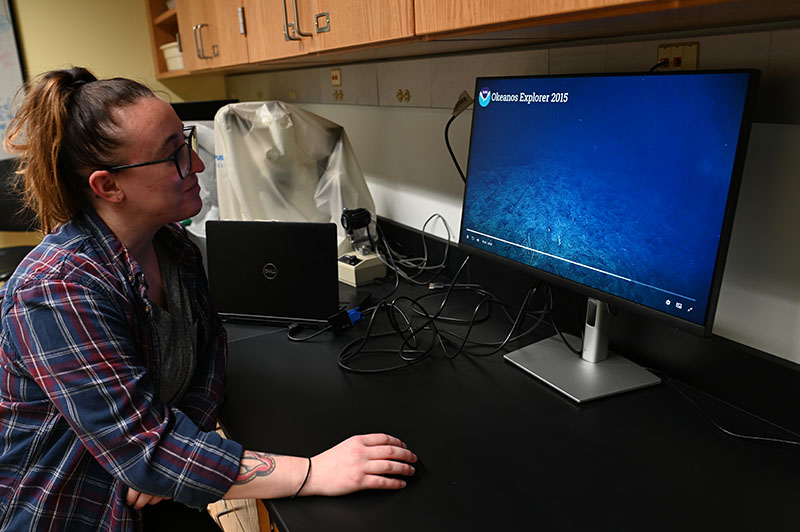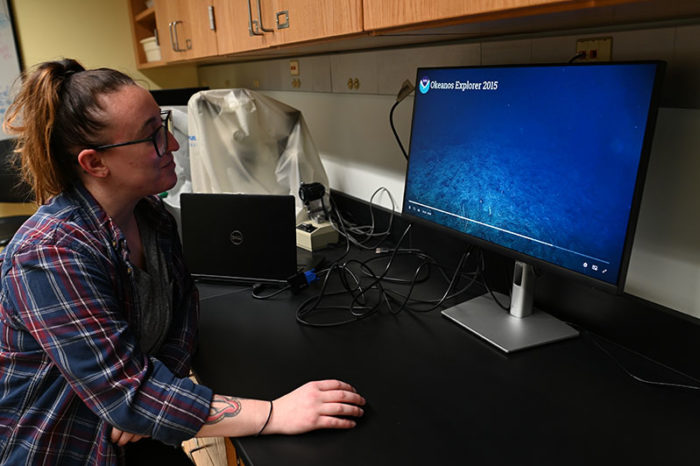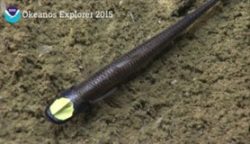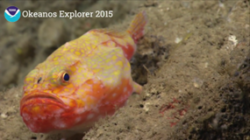
SUNY Geneseo Students Dive Into the Deep Sea with NOAA Ocean Exploration
The Research Foundation for the State University of New York on behalf of SUNY Geneseo is one of seven recipients of an Ocean Exploration Education Mini-Grant from NOAA Ocean Exploration and the National Marine Sanctuary Foundation (The Foundation). The project, spearheaded by SUNY Geneseo Assistant Professor, Mackenzie Gerringer, Ph.D., was a multi-part project designed to support students from backgrounds historically underserved and/or underrepresented in ocean exploration with research and professional development opportunities. To share resources and strategies for students from diverse backgrounds interested in entering the marine science and/or STEAM workforce, Gerringer developed a semester-long professional development and discussion series for which the entire Biology Department was invited. Additionally, project funds supported the recruitment and training of three undergraduate students from historically excluded backgrounds in marine research and analysis techniques. Each student completed an independent research project on deep-sea fish abundance and diversity using NOAA Ocean Exploration video footage collected by ROV Deep Discoverer and presented their findings at GREAT Day, SUNY Geneseo’s student research symposium.
Learn more about the research projects and students’ experiences in the blog entry written by Nikki Fuller and the poem and summary written by fellow student researcher, Gabrial Rosado.

Undergraduate researcher Nikki Fuller analyzes NOAA video footage recorded with remotely operated vehicle Deep Discoverer to determine abundance and diversity of deep-sea fishes. Photo credit: Mackenzie Gerringer
By: Nikki Fuller, Undergraduate student, SUNY Geneseo
I’ve seen trash at depths in the Caribbean Sea that are hard to imagine: depths from 250 meters to 4,058 meters. That’s a range of 2 to 37 football fields. These depths have only recently been explored by humans. We may think that these deep oceans wouldn’t have been impacted by humans directly. But, since February, we’ve cataloged over 65 pieces of garbage from human sources in 12 different dive sites around Puerto Rico. Some of the items I’ve found simply astonished me. I saw a coke can from the 1970’s in a deep-sea site called the Arecibo Amphitheater at 4,000 meters. I’ve seen single-use plastics and coffee creamers, denim, and fishing gear. Different materials and different depths—the one thing they all have in common is they haven’t decomposed. This is a reminder that our waste does not just disappear once we throw it away.

Photo credit: NOAA Ocean Exploration, Océano Profundo 2015: Exploring Puerto Rico’s Seamounts, Trenches and Troughs
I am not your standard college student. I came back to finish my bachelor’s degree when I was 30. A lot has changed between 2007 and 2020. SUNY Geneseo offered me opportunities I didn’t know were available and without those experiences I wouldn’t have found my path. I applied for a position in Dr. Gerringer’s Deep Sea Research Laboratory my last semester of senior year, for an opportunity supported by the National Marine Sanctuary Foundation. Prior to this, I had no research experience. I didn’t know what would be expected of me and further, what I should have expected to gain. In this project, Dr. Gerringer and our research team utilized NOAA’s open-source data from Okeanos Explorer expeditions in the waters of Puerto Rico. To me, the beauty of the NOAA Ocean Exploration program is the accessibility of information – it’s available to everyone, not just for research purposes.

Photo credit: NOAA Ocean Exploration, Océano Profundo 2015: Exploring Puerto Rico’s Seamounts, Trenches and Troughs
In our research, we investigated the changes in fish communities with increasing habitat depth. We investigated how factors like temperature, pressure, light, and food availability structure which fishes live where in the deep sea. We also recorded sightings of trash in Caribbean waters to understand how humans impact deep-sea environments. Watching the deep-sea videos from NOAA Ocean Exploration immersed me into a whole new world, one filled with unusual and interesting creatures, from hermit crabs using a sea anemone as a shell, to startling octopi and grumpy-looking frogmouth fish. The variety of ways these species have adapted to their unique environments is surprising and watching these videos really shed light on how little we know about the deep sea for me. One particularly fascinating fish is called a grideye fish, Ipnops murrayi. This fish is about 8 centimeters long and has a flattened plate on the top of its head that doesn’t work like other fish eyes because the eye doesn’t have a lens. Instead, Ipnops detects only changes in light from above, not forming complete images.

Photo credit: NOAA Ocean Exploration, Océano Profundo 2015: Exploring Puerto Rico’s Seamounts, Trenches and Troughs
One of my favorite fishes from the NOAA Ocean Exploration dives is Peristedion antillarum. This particular sea robin was found hanging out with a brittle star. I watched the brittle star creep slowly over to the sea robin, trying to cross over the barbels on the fish’s chin. I witnessed the Sea Robin shake the brittle star off, almost as if it was an act of annoyance. Witnessing this scene gave me new perspective on deep-sea life and an appreciation for the amazing organisms that live in the deep ocean. Without the Ocean Exploration-Education Mini-Grant through NOAA and the National Marine Sanctuary Foundation, none of this would have been possible. I would never have seen giant rocky outcrops or fault lines that run for kilometers. I wouldn’t have had the opportunity to witness the ways scientists with different specialties and backgrounds work together and to be a part of that science. And I never would have been exposed to all the paths my degree could take me, one of which is the route of environmental sciences.

Photo credit: NOAA Ocean Exploration, Océano Profundo 2015: Exploring Puerto Rico’s Seamounts, Trenches and Troughs
In Fall 2022 I will be putting into practice all the research experience I’ve gained from Dr. Gerringer, NOAA Ocean Exploration, and the National Marine Sanctuary Foundation when I start graduate school at Rochester Institute of Technology. Through the Environmental Sciences program, I aim to explore the ways that anthropogenic garbage affects our oceans and lakes, and how that debris in turn affects the species that interact with it. My experiences with this NOAA Ocean Exploration and National Marine Sanctuary Foundation-supported project make me feel more prepared to continue researching human impacts on important ecosystems.
A Sea of Science
By: Gabriel Rosado, Undergraduate student, SUNY Geneseo
The oceans are blue, as far out as we see
Beneath the waters is life at sea
We often explore, but only so deep
Thousands of meters is still pretty steep
In order to understand, we have to search and study
We take the knowledge we can, and record it with a buddy
Because it’s less beneficial to work alone
Spread the information so it’s more well known
Working on a team, geared towards a goal
The experience becomes a part of your soul
Science isn’t singular, it’s never about just one
Science is an effort that only together, we’ve done
When it’s research time, I look forward to the walk
Because I come in to learn something new from every talk
Like how some marine life doesn’t make for a pretty dish
Some are weird looking, or even have legs, like a frog fish
Under the guidance of the valiant Gerringer
Creating an experience that you can’t help but to prefer
Education becoming interactive, a hands-on approach
May make people rethink if science is what they should broach
Because we all do science, we all learn
That’s not something hard to discern
Just gather together on something clear
Focus on an issue that makes you leer
Take hold of knowledge, work with others to succeed
Maybe your research will tell humanity what we need
Like look at the garbage that plagues the ocean
More studies can be done, keep them in motion
We see fish, we see trash
We would win an award with a sash
If there was an award for pollution
Because we create the problem and the solution
But with depth comes change
Creating data in a range
As we scour along sea floors
Pondering questions, so many open doors
Our eyes and the ROV
One fish at a time is the key
Recording bit by bit to understand more
This ocean’s composition and some of its lore

Gabriel presented his research findings alongside other student researchers on the team at GREAT Day, SUNY Geneseo’s student research symposium. Photo credit: Mackenzie Gerringer
For the last semester of my senior year at SUNY Geneseo, I was lucky enough to be able to participate in research supported by the National Marine Sanctuary Foundation and NOAA Ocean Exploration. As a part of a wonderful team, led by Dr. Gerringer, we scoured ROV footage to understand different aspects of fish biodiversity around the Puerto Rico Trench. We witnessed all sorts of marine life but primarily recorded information on fishes. The experience was welcoming and amazing, I had a great time looking through information with an awesome team and everyone was quick to help as well as share with each other as needed. I had no research experience prior to joining Dr. Gerringer’s team, and the experience led me to thoroughly enjoy what I had been doing. I was not only able to perform science, but I could create poetry based on the information and experience as well. I enjoy being able to communicate scientific findings in an artistic way that is familiar to me, as I believe that art can be an effective way to reach many different types of audiences. Sharing findings in a manner that’s abstract or breaks from the norm may not only capture people’s attention, but may also serve to further educate people in science as well as draw them in. My whole experience served as a reminder that science is fun, can be done by anybody, and can be communicated in all sorts of interesting ways!
